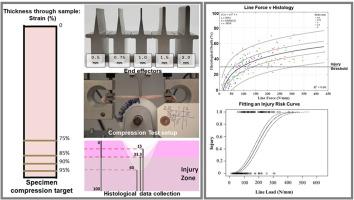Biomechanical characterization of porcine skin under focal compressive loading with varied edge radii
IF 3.5
2区 医学
Q2 ENGINEERING, BIOMEDICAL
Journal of the Mechanical Behavior of Biomedical Materials
Pub Date : 2025-08-13
DOI:10.1016/j.jmbbm.2025.107163
引用次数: 0
Abstract
There is a lack of scientific literature on the biomechanics of skin injury under focal compressive loading at various edge radii. It is understood that interactions with very small edge radii produce laceration, but as edge radii increase, the injury mechanism transitions to focal compression, and the behavior of the dermis and epidermis is not well characterized. This study quantifies effects of penetration depth and contact area of blunt, rigid hemispherical edges on loading and subsequent skin injury. A total of 172 fresh porcine skin samples were tested under normal loading using five end effectors (radii ranging from 0.2 to 2 mm) and four depths of compression (75 %, 85 %, 90 %, 95 %). Injury was defined as disruption of the epidermis and dermis exceeding 33 % of sample thickness, analyzed via digital histological methods. Results showed a clear increasing linear trend in line load (N/mm) and histological depth by radius with specimen compression. Findings suggest that tissue rupture, and thus injury, is likely a strain-based event that initiates at greater than 75 % compression. Injury was not detected at 75 % compression for any end effector but became more frequent at 85 % compression and above. No clear stratification of injury data was observed by end effector, even though local stresses increased with decreasing radius. An injury risk curve based on a Weibull fit indicates that a line load of 72 N/mm yields a 5 % risk of injury, while a line load of 200 N/mm results in a 50 % risk of injury under focal compressive loading.

猪皮肤在不同边缘半径的局部压缩载荷下的生物力学特性
关于不同边缘半径局部压缩载荷下皮肤损伤的生物力学研究缺乏科学文献。据了解,与非常小的边缘半径的相互作用会产生撕裂伤,但随着边缘半径的增加,损伤机制转变为局灶性压缩,并且真皮和表皮的行为不能很好地表征。本研究量化了钝器、刚性半球形边缘对载荷和随后皮肤损伤的穿透深度和接触面积的影响。采用5种末端执行器(半径为0.2 ~ 2mm)和4种压缩深度(75%、85%、90%、95%),对172份新鲜猪皮样品进行了正常加载测试。损伤定义为表皮和真皮的破坏超过样品厚度的33%,通过数字组织学方法进行分析。结果显示,随着试样的压缩,线载荷(N/mm)和组织深度(半径)呈明显的线性增加趋势。研究结果表明,组织破裂,因此损伤,可能是一种基于应变的事件,开始于超过75%的压缩。任何末端执行器在75%压缩时未检测到损伤,但在85%及以上压缩时更常见。末端执行器没有观察到损伤数据的明确分层,即使局部应力随着半径的减小而增加。基于威布尔拟合的损伤风险曲线表明,72 N/mm的线载荷产生5%的损伤风险,而200 N/mm的线载荷在局部压缩载荷下导致50%的损伤风险。
本文章由计算机程序翻译,如有差异,请以英文原文为准。
求助全文
约1分钟内获得全文
求助全文
来源期刊

Journal of the Mechanical Behavior of Biomedical Materials
工程技术-材料科学:生物材料
CiteScore
7.20
自引率
7.70%
发文量
505
审稿时长
46 days
期刊介绍:
The Journal of the Mechanical Behavior of Biomedical Materials is concerned with the mechanical deformation, damage and failure under applied forces, of biological material (at the tissue, cellular and molecular levels) and of biomaterials, i.e. those materials which are designed to mimic or replace biological materials.
The primary focus of the journal is the synthesis of materials science, biology, and medical and dental science. Reports of fundamental scientific investigations are welcome, as are articles concerned with the practical application of materials in medical devices. Both experimental and theoretical work is of interest; theoretical papers will normally include comparison of predictions with experimental data, though we recognize that this may not always be appropriate. The journal also publishes technical notes concerned with emerging experimental or theoretical techniques, letters to the editor and, by invitation, review articles and papers describing existing techniques for the benefit of an interdisciplinary readership.
 求助内容:
求助内容: 应助结果提醒方式:
应助结果提醒方式:


